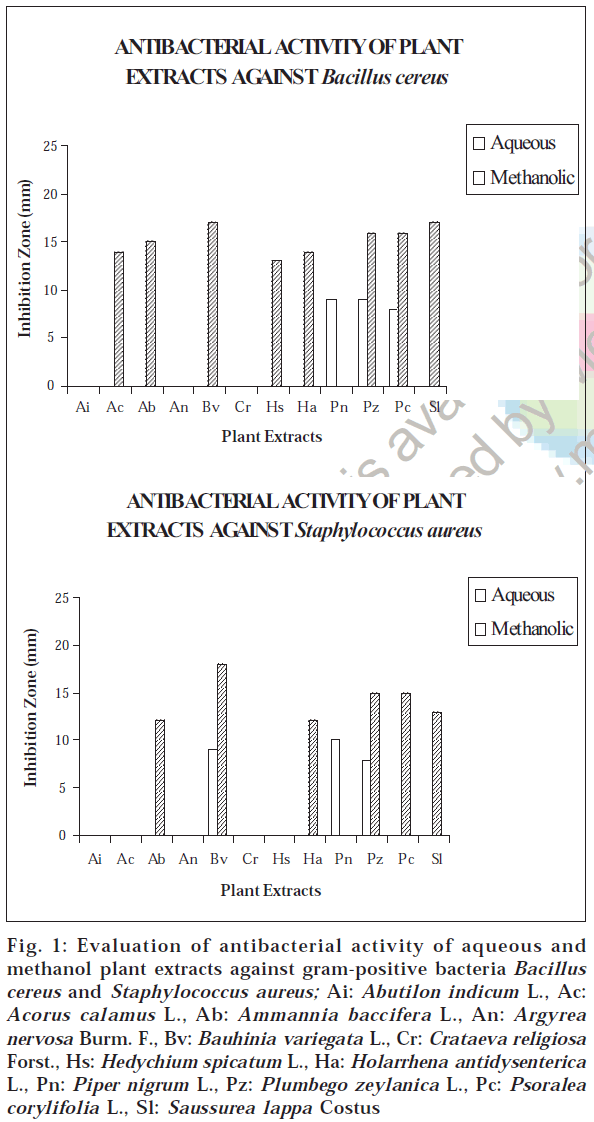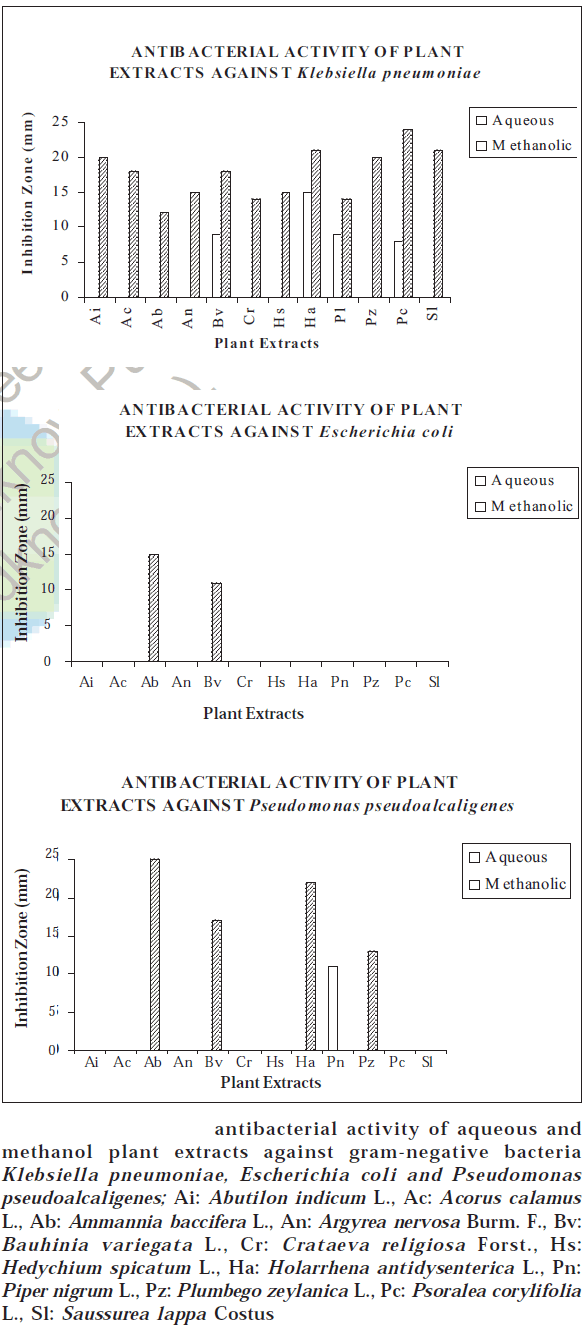- *Corresponding Author:
- Sumitra Chanda
Phytochemical, Pharmacological and microbiological laboratory, Department of biosciences, Saurashtra university, Rajkot-360 005, India
E-mail: sumitrachanda@yahoo.com
| Date of Submission | 18 July 2005 |
| Date of Revision | 29 March 2006 |
| Date of Acceptance | 28 December 2006 |
| Indian J Pharm Sci, 2006, 68 (6): 832-834 |
Abstract
In the present work an attempt has been made to carry out screening for the preliminary antibacterial activity of different plants used in Indian folk medicine. The aim of the study was to select an active plant extract which may be useful in developing new lead compounds to combat deadly diseases. Twelve plants were selected for preliminary screening for their antibacterial potentiality, viz., Abutilon indicum L., Acorous calamus L., Ammania baccifera L., Argyrea nervosa Burm. F., Bauhinia variegata L., Crataeva religiosa Forst., Hedychium spicatum L., Holarrhena antidysenterica L., Piper nigrum L., Plumbago zeylanica L., Psoralea corylifolia L., Saussurea lappa Costus. The antibacterial activity was done by both agar disc diffusion method and agar well diffusion method against five bacterial strains, viz., Bacillus cereus, Staphylococcus aureus, Klebsiella pneumoniae, Escherichia coli, Pseudomonas pseudoalcaligenes . The plant material was extracted with distilled water (aqueous) and methanol. The preliminary screening experiment revealed that methanol extracts were more potent than the aqueous extracts. The plant extracts were more active against gram-positive bacteria than gram-negative bacteria. The most susceptible bacteria were K. pneumoniae and the most resistant bacteria were E. coli . Bauhinia variegata L. exhibited remarkable antibacterial activity.
For centuries plants have been used throughout the world as drugs and remedies for various diseases [1]. Many efforts have been made to discover new antimicrobial compounds from various kinds of sources such as soil, microorganisms, animals and plants [2]. One such resource is folk medicines, and systematic screening of these may result in the discovery of novel effective compounds [3].
Making antibacterial drug therapy effective, safe and affordable has been the focus of interest during recent years [4]. There are several reports on antimicrobial activity of different herbal extracts [5–9]. Considering the above aspects, an attempt has been made to carry out the screening for preliminary antibacterial activity of different plants used in Indian folk medicine. The most potent plant extract was selected for further study. The aim of the study was to select an active plant extract which may be useful in developing new lead compounds to combat deadly diseases.
plants used in Indian folk medicine. The most potent plant extract was selected for further study. The aim of the study was to select an active plant extract which may be useful in developing new lead compounds to combat deadly diseases. Plant parts were collected from Shrikant Pharmacy, Keshod. The material was collected in the form of dried parts, powdered and stored in airtight bottles. The identification of plant material was confirmed at the Department of Biosciences, Saurashtra University, Rajkot.
Ten grams of plant material were extracted with distilled water for 6 h at slow heat. At an interval of 2 h, it was filtered through eight layers of muslin cloth and centrifuged at 5000×g for 5 min. The supernatant was concentrated to one-fifth of the original volume. The extract was autoclaved and stored at 4°C. This gave an aqueous extract of the plant material. In order to obtain a methanol extract, 10 g of plant material was extracted with 100 ml of methanol and kept overnight on a rotary shaker. The extract was filtered and centrifuged at 5000×g for 5 min. The filtrate was concentrated to one-fifth of the original volume and stored at 4°C.
The test organisms included the gram-positive bacteria Bacillus cereus (ATCC11778), Staphylococcus aureus (ATCC25923) and gram-negative bacteria Klebsiella pneumoniae (NCIM 2719), Escherichia coli (ATCC25922), Pseudomonas pseudoalcaligenes (ATCC17440). All the bacterial strains were obtained from National Chemical Laboratory (NCL), Pune, India. The bacteria were grown in the nutrient broth at 37°C and maintained on nutrient agar slants at 4°C.
The aqueous and methanol extracts were screened for potential antibacterial activity by agar disc diffusion method [10] with disc size of 7 mm (HiMedia) and agar well diffusion method [11] with cup borer of size 8.5 mm respectively. For all the bacterial strains, overnight cultures grown in nutrient broth were adjusted to an inoculum size of 108 cells/ml for inoculation of the agar plates. An aliquot (0.2 ml) of inoculum was added to the molten Mueller Hinton agar No. 2 medium (HiMedia). For both the methods, well and discs were introduced with 0.1 ml each of the aqueous and methanol extract. Distilled water and methanol were taken as control. Following an incubation period of 24 h at 37°, antibacterial activity was evaluated by quantifying zones of inhibition of bacterial growth. (mean of three replicates was considered). The entire microbial assay was carried out three times under strict aseptic conditions. The result of screening is shown in the graph (figs. 1 and 2).
Figure 1: Evaluation of antibacterial activity of aqueous and methanol plant extracts against gram-positive bacteria Bacillus cereus and Staphylococcus aureus; Ai: Abutilon indicum L., Ac: Acorus calamus L., Ab: Ammannia baccifera L., An: Argyrea nervosa Burm. F., Bv: Bauhinia variegata L., Cr: Crataeva religiosa Forst., Hs: Hedychium spicatum L., Ha: Holarrhena antidysenterica L., Pn: Piper nigrum L., Pz: Plumbego zeylanica L., Pc: Psoralea corylifolia L., Sl: Saussurea lappa Costus
Figure 2: Antibacterial activity of aqueous and methanol plant extracts against gram-negative bacteria Klebsiella pneumoniae, Escherichia coli and Pseudomonas pseudoalcaligenes; Ai: Abutilon indicum L., Ac: Acorus calamus L., Ab: Ammannia baccifera L., An: Argyrea nervosa Burm. F., Bv: Bauhinia variegata L., Cr: Crataeva religiosa Forst., Hs: Hedychium spicatum L., Ha: Holarrhena antidysenterica L., Pn: Piper nigrum L., Pz: Plumbego zeylanica L., Pc: Psoralea corylifolia L., Sl: Saussurea lappa Costus
The complete details of the plants screened in this work are shown in Table 1. A total of 24 extracts (aqueous and methanol) from 12 different plant species belonging to 12 different families were screened for potential antibacterial activity (figs. 1 and 2). Most of the extracts were more active against gram-positive bacteria than gram-negative bacteria, which is in agreement with previous reports that plant extracts are more active against gram-positive bacteria than gram-negative bacteria [12,13]. Amongst aqueous and methanol extracts of the studied plant species, methanol extracts were found to be more active than the aqueous extracts except for Piper nigrum L.
| Plant species | Family | Common name | Habitat | Part used |
|---|---|---|---|---|
| Abutilon indicum L. | Malvaceae | Kansaki | herb | Leaves |
| Acorus calamus L. | Araceae | Vaj | herb | Rhizomes |
| Ammannia baccifera L. | Lythraceae | Jalagio | herb | Whole plant |
| Argyrea nervosa Burm. F. | Convolvulaceae | Samudrasosh | shrub | Leaves |
| Bauhinia variegata L. | Caesalpiniaceae | Kanchnar | tree | Bark skin |
| Crataeva religiosa Forst. | Cappparidaceae | Varunchaal | tree | Bark skin |
| Hedychium spicatum L. | Scitaminaceae | KapurKachli | herb | Root |
| Holarrhena antidysenterica L. | Apocynaceae | KadaChal | shrub | Bark skin |
| Piper nigrum L. | Piperaceae | Chavak | climber | Root |
| Plumbego zeylanica L. | Plumbagenaceae | Chitrak | shrub | Root |
| Psoralea corylifolia L. | Leguminosae | Bavchi | herb | Seeds |
| Saussurealappa Costus. | Composite | Kuth or uplet | herb | Root |
Ethnobotanical information such as family, common name, habitat and the plant part used in the study of some traditionally used medicinal plants
Table 1: Ethnobotanical information of some traditionally used indian medicinal plant species selected for antibacterial activity
Aqueous extracts of Abutilon indicum L., Acorus calamus L., Ammania baccifera L., Argyria nervosa Burm. F., Crataeva religiosa Forst., Hedychium spicatum L. and Saussurea lappa Costus. were totally inactive against all the investigated microorganisms (figs. 1 and 2). Amongst all the five investigated bacterial strains, K. pneumoniae was the most sensitive bacteria and E. coli was the most resistant bacteria.
The results obtained from screening showed that the folklore use of some of the plants is justified. Bauhinia variegata L. exhibited remarkable antibacterial activity amongst all the 12 plant species, for which it can be selected for further studies.
References
- UNESCO: Culture and Health, Orientation- Texts World Decade for Cultural Development 1988-1997, Document CLT/DEC/PRO, Paris,France, 1996.
- Bhavnani, S.M. and Ballow, C.H., Curr. Opin.Microbiol., 2000, 3: 528
- Janovska, D., Kubikov, K. and Kokosk, L., Czeck. J. Food Sci.,2003, 21, 107.
- Sharma, K.K., Sangraula, H. and Mediratta, P. K., Indian J. Pharmacol., 2002, 34, 390.
- Adelakun, E.A., Finbar, E.A., Agina, S.E. and Makinde, A.A.,Fitoterapia, 2001, 72, 822.
- Camporese, A., Balik, M.J., Arvigo, R., Esposito, R.G., Morsellino, N., De Simone, F. and Tubaro, A., J. Ethnopharmacol., 2003, 87, 103.
- Bonjar, S., J. Ethanopharmacol., 2004, 94, 301.
- de Boer, H.J., Kool, A., Broberg, A., Mziray, W.R., Hedberg, I. and Levenfors J.J., J. Ethnopharmacol., 2005, 96, 461.
- Nair, R., Kalariya, T. and Chanda, S., Turk. J. Biol., 2005, 29, 41.
- Bauer, A.W., Kirby, W.M.M., Sherris, J.C. and Turck., M., Amer. J. Clin. Pathol., 1966, 45, 493.
- Perez, C., Paul, M. and Bazerque, P., Acta. Bio. Med. Exp.1990, 15, 113.
- Vlietinck, A.J., van Hoof, L., Totte, J., Lasure, A., VandenBerghe, D., Rwangobo, P.C. and Mvukiyuniwami, J., J. Ethnopharmacol., 1995, 46, 31.
- Rabe, T. and van Staden, J., J. Ethnopharmacol.,

